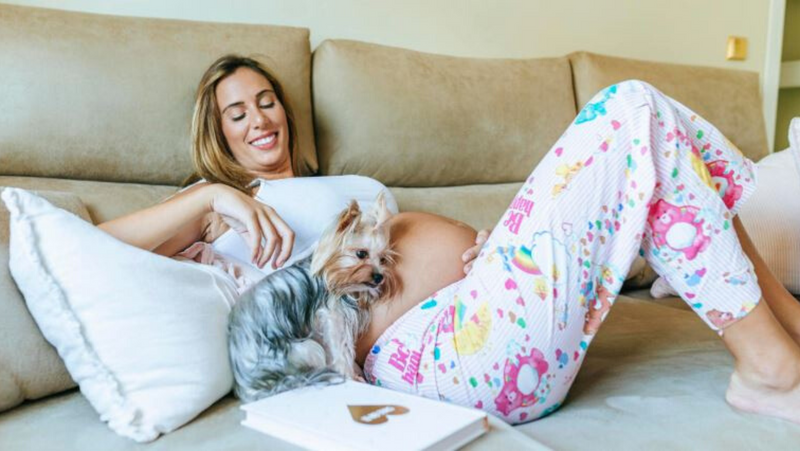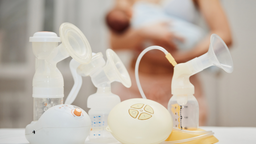EXPERT ADVICE ON GETTING YOUR FOUR-LEGGED BABY READY FOR YOUR HUMAN BABY.
Why is it important to prepare a dog for the arrival of a new baby?
In many families, the dog was the first and only “baby.” Once the new human baby arrives, the dog’s daily structure, routines, and relationship with the parents of the new baby will change. Dogs thrive on consistency and routine. Abrupt and extreme changes can create anxiety which may lead to a variety of behavior problems. By preparing ahead, expectant parents can gradually teach the dog how life will be different, but that different will still be good.
What problems could arise if a dog hasn’t spent much time around babies?
Dogs who have had little or no experience can react in a variety of ways towards an infant in the home. Most dogs will exhibit some level of stress and anxiousness and may cope by avoiding the baby as much as possible. Other dogs may become over stimulated by the infant’s movements and cries and want to investigate. This can range from just extreme curiosity to potentially unsafe behaviors such as becoming hyper aroused, jumping at, and trying to physically get near the infant.
What is the arrival of a new baby like from a dog’s perspective?
It varies a lot based on how much if any preparation the parents did to help the dog get ready. Has the dog had any previous experience with babies or toddlers? Was it a good experience or was it a situation where a baby was allowed to crawl and sit on top of dog and bounce around? So many people assume their dogs “love kids or love babies” but in reality most are just tolerating what is going on and don’t necessarily enjoy the interactions. Dogs have their breaking point just like people do.
For most dogs, a new baby initially brings about a certain amount of anxiousness. Their humans are acting differently now, which affects them too. The dog is no longer the center of attention and sometimes isn’t getting any attention at all. This is such an important moment to start creating a positive association to the new infant. A tired and euphoric new parent may not realize that they are yelling at their dog every time they have the baby in their arms. What sort of association is now being made? The dog perceives: “Whenever that little wiggly creature is around, I get yelled at or sent away!”
Can you share a few tips for preparing a dog in advance of the arrival of a new baby, and for introducing the new baby?
One of the first things I recommend is coming up with at least three places you can confine the dog in your home. This could be a cozy dog crate or den (as I like to call it), a room that can be closed off, a fenced back yard, or an indoor tether next to a comfy dog bed. If the dog currently isn’t used to some of these things, then it’s important to start training the dog as soon as possible. Using lots of positive reinforcement, the dog will learn that these places are great places to be. I recommend at least three places because you’ll want to rotate the dog from one “success station” to the next, so they are not always stuck in the same environment. Success stations always equal yummy bones or exciting puzzle toys!
Another area to work on is strengthening obedience training - in particular sit, down, and stay. Most dogs who have had some basic training will respond when their person is in that “trainer’s stance” - standing tall, looking down at them. Can your dog respond when you are seated? When you are reclining? When you are seated or reclining with a baby in your arms? Will they sit, down, and stay using verbal cues without any hand signals? Remember, your hands will be occupied soon! Practice now and reward your dog generously as he learns to respond to you no matter what position you are in or when your arms are full.
So many parents worry about that moment of bringing the baby home for the first time. It really should be a non-event. In fact, if either parent is feeling unsure and uncomfortable, there is no reason the dog needs to meet the baby that day, or the next, or that week even. Moms especially need to be focused on rest and recovery so if they would feel better having the dog stay a few days or a week with a friend, family member, or at a dog boarding facility, that is perfectly alright.
If they want to start introductions right away, I like to have Mom go in the house first, without the baby. Her hormones have changed a lot and the dog will need a little time to sniff and get accustomed to her new scent. The dog may have not seen her for a few days or even longer so he will be especially excited to greet her. After Mom has had a few minutes with the dog, the partner or another family member can bring in the baby in the car seat.
Set the baby up high on a table and stand near as the dog first gets accustomed to the new scent and sounds. The dog should have a leash attached that someone can gently grab ahold of if he is getting too exuberant to see the new baby. If the dog is doing well at this point, then one of the parents may remove and hold the infant. Ask the dog to sit frequently and give lots of praise for good behavior. There is no reason the dog has to actually have contact with the infant at this point. You’re just starting off with getting the dog used to visually seeing the infant while practicing good manners and getting lots of praise and tasty treats. The parents can also allow the dog to sniff some clothes or blankets the baby was wearing. There is no need to rush into anything. Go day by day and only within your comfort zone, based on how well your dog has been responding.
What are some warning signs that a dog is experiencing stress because of the new baby?
Dogs may exhibit one or many signs that they are feeling stress. It may be from the presence of the new baby or it could be from the changes happening within the household such as changes in sleeping, play, and exercise routines. If the household didn’t have many visitors before the baby came, and now there is a steady stream of visitors, that can cause stress for some dogs as well. Some signs of stress may be excessive yawning or scratching for no apparent reason, frequent lip or nose licking, panting heavily, pacing, and trembling.
You know your dog better than anyone else. If your dog starts exhibiting behaviors that you’ve never seen before, it very well could be stress related. If you have any concerns, you should contact a certified trainer or behaviorist. They can come to the home and do an in-home behavior consultation and evaluation of the dog and come up with a behavior modification plan or other options that will work for your family.
Expectant families can find an approved and licensed Dogs and Storks presenter in their area by going to the Family Paws Parent Education site. There they can find a lot of free informational resources there as well as listen to webinars and podcasts.



